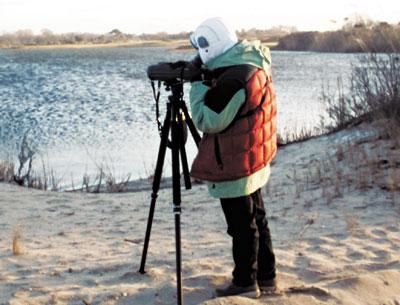Razorbills And Mergansers, Ho! But Alcids, No

“Harrier, harrier, harrier!” Vicki Bustamante yelled, her eye downward peering into her Swarovski birding scope early Saturday morning as a biting northwest wind buffeted her parka. The low January sun threatened not to rise much farther and the chopped surface of Hook Pond made it hard to count the waterfowl she was scoping.
The annual New York State Ornithological Association survey was what had Ms. Bustamante and her cohorts, Karen Rubenstein and her sister Barbara, perched head-down behind tripods. They were counting by tens within their respective fields of vision, ID-ing species against the howl of the wind with the bravado of auctioneers.
“Bonies, they’re Bonies, see the white leading edges,” Ms. Bustamante announced, briefly leaving her scope to watch two Bonaparte gulls struggling against the wind. Bonies and harrier hawks are not waterfowl, of course, but the three surveyors are birders by nature, so anything with feathers earned a shout-out.
“I’ve got one merganser, two razorbills!” shouted Ms. Bustamante. “We don’t count alcids,” she informed a tagalong, alcids being diving seabirds.
“I’ve got 63 black ducks,” Karen Rubenstein barked against the wind. There followed a good 10 minutes of studied, telescopic silence.
Saturday’s duck count was part of a statewide effort to compile statistics in cooperation with the State Department of Environmental Conservation. The Ornithological Association divides the state up into regions. The regions do not correspond with the D.E.C.’s management areas. There are 25 survey areas within Long Island’s Region 10, including New York City.
On the South Fork, the South Fork Natural History Museum oversees the count in four areas: Shinnecock to Water Mill, Amagansett to East Hampton, Mecox Bay, and Montauk. Two of the four areas were covered by other teams on Saturday. The Montauk count took place this week. All the surveys must be made between Jan. 19 and Jan. 27.
The duck count is not to be confused with the National Audubon Society’s annual Christmas bird count that takes place between Dec. 14 and Jan. 5 and involves tens of thousands of volunteers throughout North and South America.
Ron Bourque is a veteran birder who has been involved in the annual Mid-Winter Waterfowl count for the past decade. He is the regional “compiler” of the numbers that come in from all over the Island and the city.
“I transpose all the data onto an Excel spreadsheet and send it to the association. They look for trends,” Mr. Bourque said, going on to describe the span of the project whose data goes back three decades. In all, 47 species are counted, including cormorants, coots, grebes, and loons. Why count them midwinter, Mr. Bourque was asked.
“There are a lot of inland birds that normally breed in lakes, rivers, and ponds. It’s their regular habitat, but when it freezes, they head for the Atlantic Ocean. They come out to saltwater because it’s a place to feed,” Mr. Bourque said. The Ornithological Association’s avian records committee has been compiling annual reports since 1977.
“I have 1,200 Canadians,” Ms. Bustamante said. “Sometimes we see greater white-fronted geese, and snow geese. A lot of mergansers lately. I don’t think we’ll pull much more out of here,” she said, folding the legs of her tripod.
The duck counters repaired to the warmth of their cars and headed for Georgica Pond to compile their stats, but with binoculars at the ready.
